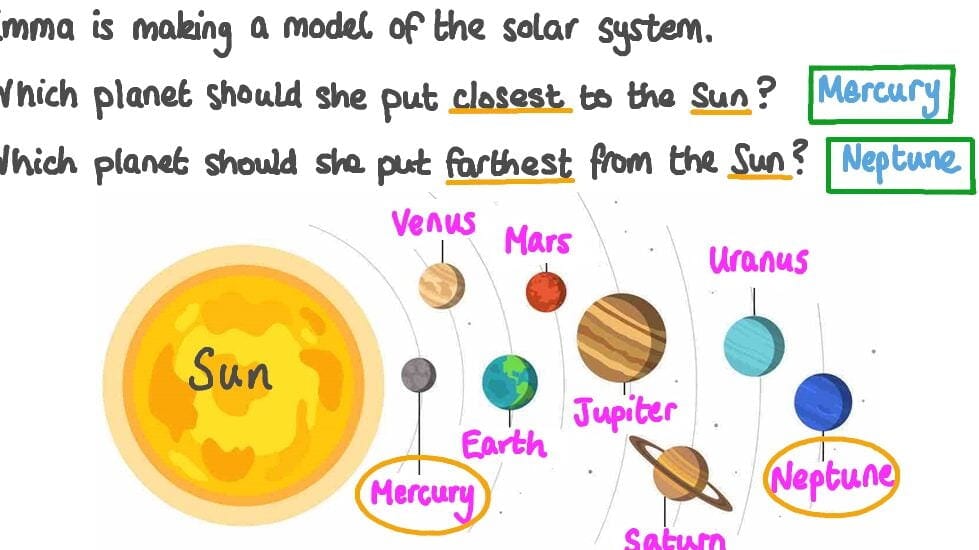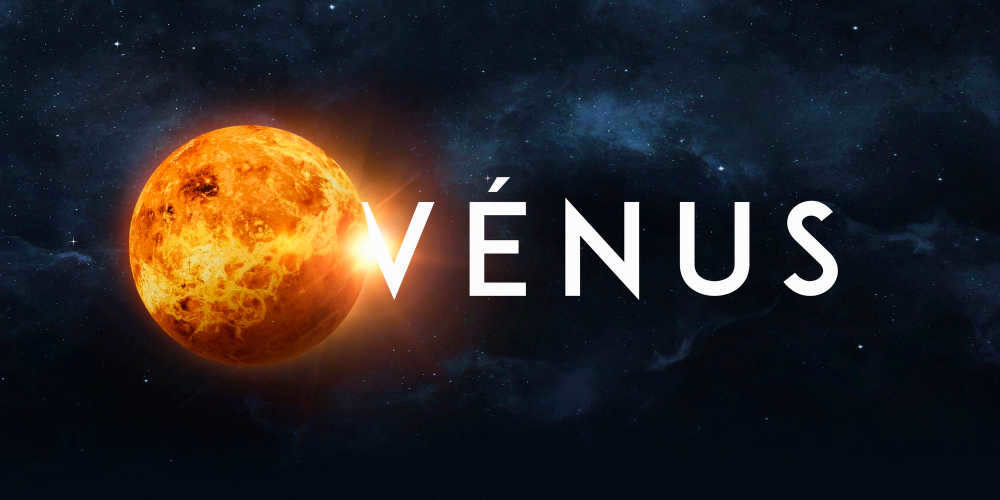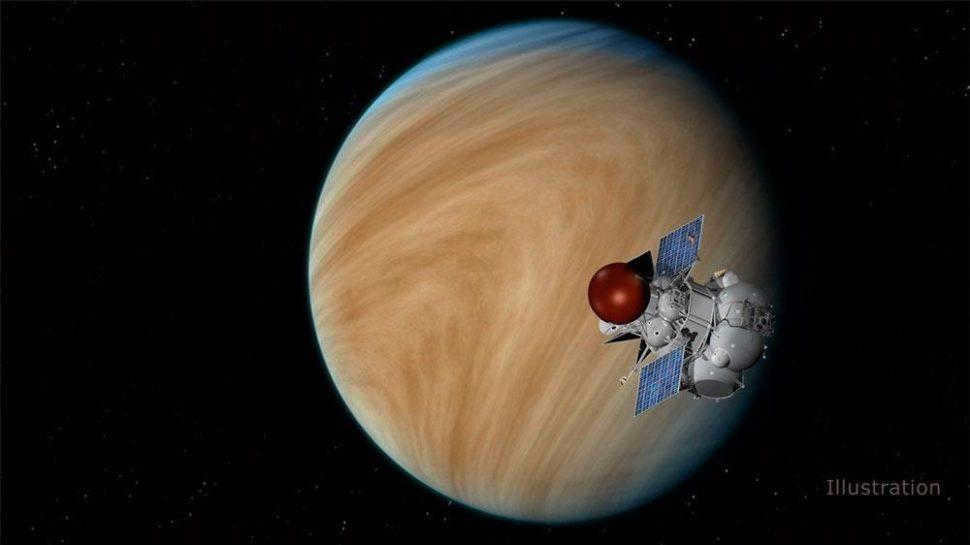
Situated between the orbits of Mercury and Earth, Venus has become a subject of extensive exploration due to its prime position for observations. What intriguing details can we uncover about this celestial body known as the “morning star”?
Similar to Earth
Venus is often referred to as the “sister planet” of Earth due to its similarities. In terms of size, Venus is very close to Earth’s dimensions. While Earth has a radius of 6358.6 km, Venus has a radius of 6051.8 km, making it only 5% smaller. Additionally, Venus has a mass that is 81% of Earth’s mass, making its gravitational force very similar to Earth’s at 0.9g (compared to Earth’s 1 g).
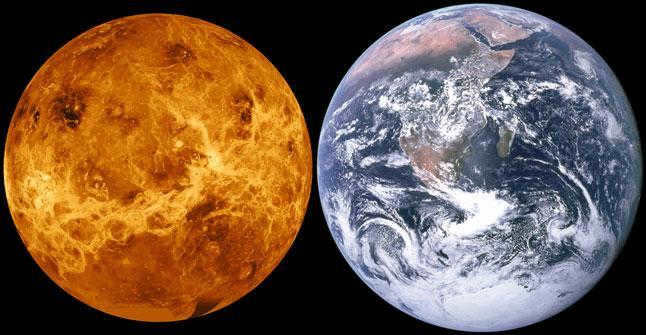
The resemblance between Venus and Earth gives us reason to believe that in the future, humanity will establish colonies on the “morning star.” Nonetheless, there is a significant obstacle to this endeavor: the climate.
During the 19th century, scientists had high hopes that the conditions on Venus would resemble those that existed on Earth during the time of the dinosaurs. Analysis of the planet’s distance from the Sun indicated that there should be liquid water on the “morning star,” but the presence of constant clouds prevented the hypothetical ocean from being considered.
However, upon further exploration of the planet, it was discovered that the temperature on Venus reaches a scorching 477 ° C, with minimal fluctuations. This makes Venus much hotter than Mercury, which is actually closer to the Sun. What could possibly explain this perplexing anomaly?
An extraordinary ambience
The peculiarity lies within the very clouds that concealed the planet’s terrain from inquisitive inhabitants of Earth. Evidently, its atmosphere possesses a density that is two magnitudes higher than that of the Earth’s. The pressure at ground level reaches a staggering 93 atm, a burden comparable to the depths of the ocean at approximately 900 meters. The composition of the atmosphere consists predominantly of 96% carbon dioxide. This particular composition engenders a greenhouse effect on the planet, thereby elevating its surface temperature to remarkable degrees. Intriguingly enough, the planet experiences precipitation, albeit in the form of sulfuric acid rather than water.
If the atmosphere of “sister Earth” were truly similar to that of Earth, the temperature on it would not exceed 80 °C, which would provide favorable conditions for the emergence of life. However, there is optimism that certain life forms may exist either in the planet’s clouds or beneath the surface, where the temperatures are not as extreme.
We must acknowledge that the planet’s climate has not always been as it is now. Billions of years ago, the Sun did not radiate as intensely, allowing for the possibility of a liquid ocean on Venus. In fact, astrobiologist David Grinspoon proposes a theory suggesting that life initially originated on Venus and was subsequently transported to Earth via meteorites containing Venusian material.
Explored prior to other celestial bodies
Venus, following the Moon, took precedence as the primary target for numerous space programs. Specifically, in 1962, the Mariner 2 probe conducted a flyby of the planet and gathered valuable information. This marked the inaugural exploration of another planet by a space probe. Subsequently, in 1970, the Soviet spacecraft Venera-7 achieved a gentle touchdown on the Venusian surface, while Mars’ surface remained uncharted until 1971.
However, even in ancient times, the “morning star” captivated priests more than any other celestial bodies. Historians assert that it was the foremost entity to have its movements documented on a stellar map.
The proximity between Earth and Venus can be as little as 38 million kilometers. There is no other planet that comes as close to us. On average, though, the closest planet to Earth is Mercury.
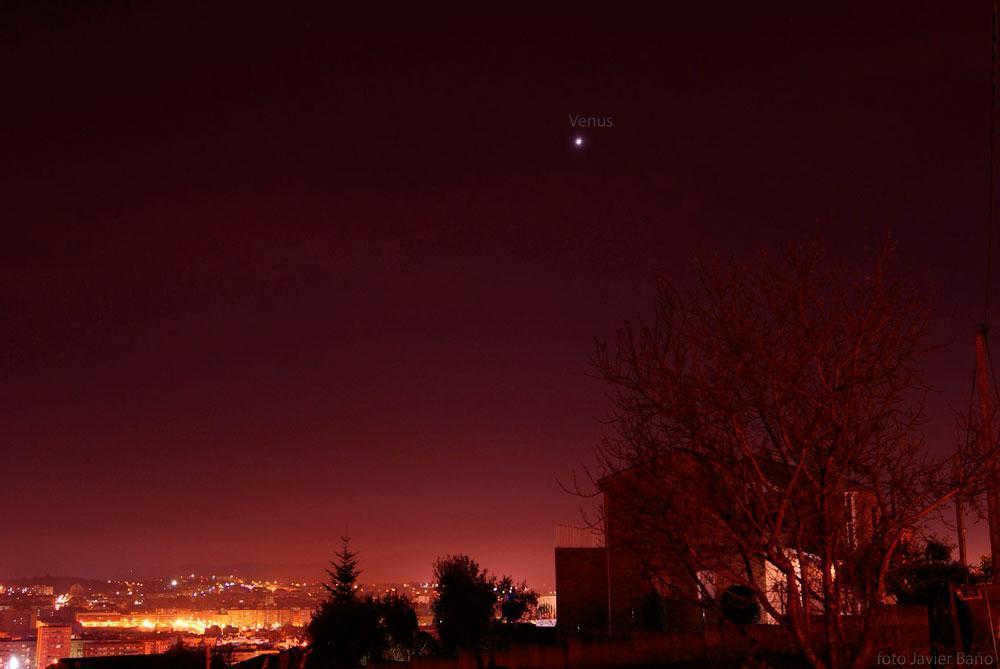
Venus is the most luminous celestial body in the sky, after the Sun and the Moon, due to its proximity to Earth, large size, and the high reflectivity of its white clouds. Its brightness can vary from -3.8 to -4.6, which is significantly higher than that of Jupiter, the planet that comes after Venus in terms of brightness.
It has a unique rotation compared to other planets
In our planetary system, all planets have a consistent pattern of rotating on their axis from west to east. However, there are a couple of exceptions. Venus, for instance, spins in the opposite direction. Another planet with an unusual rotation is Uranus, but its peculiarity is different. Uranus’s axis of rotation is almost aligned with the plane of its orbit, giving it the appearance of rolling in its orbit. Astronomers refer to this uncommon behavior as “retrograde motion.”
Scientists have yet to fully comprehend the reasons behind this anomaly. One possibility is that Venus experienced a tangential collision with another massive celestial object in the past, which altered its rotation in the opposite direction.
A day that seems to never end
Venus has a unique characteristic when it comes to its rotation – it spins incredibly slowly. It takes a whopping 243 Earth days for Venus to complete one full rotation on its axis. In comparison, it only takes 224.6 days for Venus to complete its orbit around the Sun. This means that a day on Venus is actually longer than a year!
Currently, Venus lacks any natural satellites. However, there exists a hypothesis suggesting that Mercury may have once been a satellite of Venus. This theory offers a possible explanation for multiple characteristics observed on both planets. The counter-rotational movement of Venus and its excessive heating could be attributed to the tidal forces exerted by a large satellite. As for the peculiar traits of Mercury, indicative of its potential lunar origin, we can consider its liquid core, as revealed by recent findings, and its highly elongated elliptical orbit.
Venus exhibits phases similar to the Moon
It is well-known that the Moon undergoes various phases in the night sky, appearing as a complete circle during a full moon and as a slender crescent during other times. Interestingly, Venus also experiences phases, although they can only be observed through a telescope. The first person to document these phases was Galileo Galilei in 1610. This discovery shed light on the fact that Venus derives its illumination from the Sun’s reflected light, rather than emitting its own light. Additionally, unlike the Moon, which disappears completely during its new moon phase, Venus does not experience a similar period of complete disappearance. This further supports the heliocentric model of the universe proposed by Copernicus.
Its surface is devoid of nearly any craters
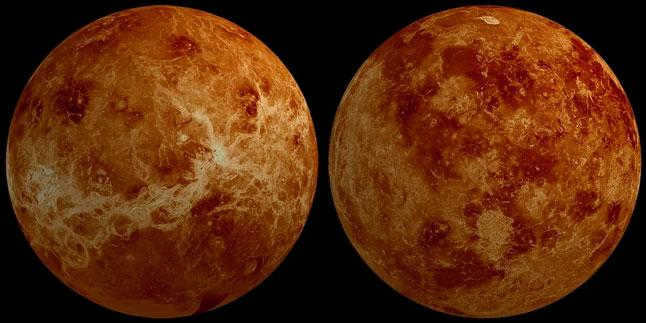
When examining the relief of Venus, it becomes apparent that there are relatively few craters on its surface, numbering no more than 1000. This may seem surprising, considering the planet’s inability to “accidentally” avoid collisions with asteroids. However, Venus does not actively avoid these collisions; rather, its topography is constantly renewed due to its high level of volcanic activity. Scientists estimate that the current surface of Venus is only around 500 million years old, which means that any traces of earlier collisions have been erased over time.
Related articles
List of sources used
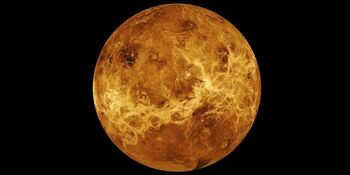
Venus, the second planet from the sun, is also known as the hottest planet in our solar system. Throughout history, Venus has been an ever-present celestial body, often referred to as the evening star and admired for its brilliance. Even before its planetary nature was fully understood, ancient civilizations recognized its significance and incorporated it into their mythology and cultural practices. As time has passed, our fascination with Venus has only deepened, and the observations made throughout the centuries have greatly contributed to our understanding of the overall structure of our solar system.
Fascinating information about Venus [ ]
- Venus completes one axial revolution (sideric day) in 243 days, while its orbital path takes 225 days. A solar day on Venus lasts for 117 days.
- Venus rotates in the opposite direction, a phenomenon known as retrograde. It is believed that Venus may have had a collision with a large asteroid in the past. Interestingly, Venus does not have any satellites.
- From the perspective of an observer on Earth, only the Moon appears brighter than Venus. With a magnitude ranging from -3.8 to -4.6, the planet is so luminous that it can be seen in the middle of the day on occasion.
- Despite being similar in size to Earth, Venus has a surface that is not as heavily cratered. This is due to its dense atmosphere, which destroys incoming asteroids. The pressure on Venus’ surface is comparable to that experienced at great depths.
- There is a difference of 638 km in their diameters, and Venus has a mass that is 81.5% of Earth’s. Additionally, they share a similar structure.
- Ancient civilizations believed that they were observing two distinct celestial bodies: Lucifer and Vesper (in Roman mythology). This belief was based on the fact that Venus’s orbit is closer to the Sun than Earth’s, causing it to appear as a bright “morning star” or “evening star” during different times of the day. The Mayans described this phenomenon in great detail around 650 BC.
- Venus has a temperature index that can reach up to 462°C. Unlike Earth, Venus has a minimal axial tilt, resulting in a lack of distinct seasons. The planet’s dense atmosphere is primarily composed of carbon dioxide (96.5%), which creates a greenhouse effect by trapping heat.
- The Venus Express was launched in 2006 and successfully entered the planet’s orbit. Originally planned for a 500-day mission, it was later extended until 2015. During its time in orbit, the spacecraft discovered over a thousand volcanoes and volcanic centers, some of which measured 20 km in length.
- In 1961, the Soviet probe Venera-1 was sent to Venus, but contact was quickly lost. The same fate befell the American Mariner-1. However, in 1966, the USSR achieved a breakthrough by successfully deploying the first lander, Venera-3. This enabled scientists to observe the surface of Venus, which had been hidden behind a dense layer of acidic haze. In the 1960s, the introduction of radiographic mapping technology greatly advanced research on the planet. It is believed that Venus may have had oceans in the past, but these evaporated as temperatures rose.
Size, mass and orbit of the planet Venus [ ]
Venus is often referred to as Earth’s sister due to the many similarities between the two planets. In terms of mass, Venus weighs 4.8866 x 10 24 kg, which is about 81.5% of Earth’s mass. The planet has a surface area of 4.60 x 10 8 km 2, accounting for 90% of Earth’s surface area, and a volume of 9.28 x 10 11 km 3, which is approximately 86.6% of Earth’s volume.
When it comes to its orbit, Venus is located 0.72 astronomical units (108,000,000 km) away from our star, the Sun. Its orbit is nearly circular, with an aphelion of 108,939,000 km and a perihelion of 107,477,000 km. This makes Venus have the most circular orbital path among all the planets.
When Venus aligns between Earth and the Sun, it comes closest to our planet compared to all other planets, at a distance of 41 million kilometers. This alignment occurs every 584 days. The orbital period of Venus is 224.65 days, which is about 61.5% of Earth’s orbital path.
Venus is quite an extraordinary planet and has several unique characteristics. Unlike most celestial bodies in our solar system that orbit in a counterclockwise direction, Venus has a clockwise orbit. Furthermore, Venus has an incredibly slow rotation, with one day on Venus lasting for 243 Earth days. Interestingly, this means that a day on Venus is actually longer than a year on the planet.
The Structure and Surface of Venus
Venus is believed to have a similar internal structure to Earth, consisting of a core, mantle, and crust. However, there are notable differences between the two planets. The core of Venus is thought to be at least partially liquid, indicating that both Venus and Earth cooled at a similar rate.
One key difference is in plate tectonics. The crust of Venus is stronger than that of Earth, resulting in less heat loss. This difference may be the reason why Venus lacks an internal magnetic field.
The surface of Venus was shaped by volcanic activity. There are approximately 167 large volcanoes on Venus, surpassing the number found on Earth. These volcanoes reach heights of over 100 km. Their presence suggests a lack of tectonic movement and an ancient crust. The estimated age of Venus’ crust is between 300 and 600 million years.
Additionally, there were observations made regarding fluctuations in the levels of sulfur dioxide, which provide evidence for volcanic eruptions. The infrared view also detects the presence of hot spots, indicating the presence of lava. It is evident that the surface is well-preserved, featuring around 1000 craters with diameters ranging from 3 to 280 kilometers.
You won’t find any smaller craters, as small asteroids burn up in the dense atmosphere. In order to make an impact on the surface, an asteroid must exceed a diameter of 50 meters.
Atmosphere and Temperature of the Planet Venus
Observing the surface of Venus used to be incredibly challenging due to a dense atmospheric haze composed mainly of carbon dioxide, with small amounts of nitrogen. The atmospheric pressure on Venus is 92 bars, and the mass of the atmosphere is 93 times that of Earth.
It’s important to note that Venus holds the record for being the hottest planet in our solar system. The average temperature on Venus is a scorching 462°C, which remains stable throughout the day and night. This extreme heat is a result of the significant amounts of CO2 present in the atmosphere, along with clouds of sulphur dioxide, creating a potent greenhouse effect.
The surface of Venus is characterized by a consistent temperature distribution, unaffected by any changes in the temperature index. Additionally, Venus has a small axial tilt of 3°, which eliminates the presence of distinct seasons. Temperature variations are only observed with changes in altitude.
It is important to mention that the temperature at the peak of Maxwell’s Mountain reaches 380°C, and the atmospheric pressure is 45 bar.
If you happen to be on the planet, you will immediately come across strong wind currents, with speeds reaching 85 km/s. These winds circumnavigate the entire planet in 4-5 days. Furthermore, dense clouds have the ability to generate lightning.
Study History of Venus
Ancient civilizations were aware of the existence of Venus, but they mistakenly believed that there were two separate celestial objects: the morning star and the evening star. It wasn’t until the 6th century B.C. that Venus was officially recognized as a single planet. However, as early as 1581 B.C., a Babylonian tablet clearly explained the true nature of the planet.
Venus became synonymous with the goddess of love for many cultures. The Greeks named it after Aphrodite, and the Romans referred to its morning appearance as Lucifer.
In 1032, Avicenne made the first observation of Venus passing in front of the Sun, leading him to realize that the planet was closer to Earth than the Sun. In the 12th century, Ibn Bajaj discovered two dark spots, which were later explained as the transits of Venus and Mercury.
In 1639, Jeremiah Horrocks observed the transit. During the early 17th century, Galileo Galilei utilized his instrument and documented the phases of the planet. This significant observation confirmed that Venus had passed in front of the Sun, providing support for Copernicus’ theory.
In 1761, Mikhail Lomonosov made a groundbreaking discovery of an atmosphere on the planet, which was later confirmed by Johannes Schroeter in 1790.
In 1866, Chester Lyman conducted a notable observation where he observed a complete ring of light surrounding the dark side of the planet, further indicating the presence of an atmosphere. The first ultraviolet survey of Venus was conducted in the 1920s.
In the 1960s, radar technology was utilized and made significant progress in obtaining rotation readings, bringing us closer to modern capabilities. The Arecibo Observatory played a crucial role in providing detailed information about Mount Maxwell and other features.
Delving into the Exploration of Venus [ ]
The Soviet Union took an active interest in studying Venus during this period and launched multiple spacecraft in the 1960s. Unfortunately, the initial mission was unsuccessful, failing to even reach the planet.
A similar outcome occurred with the United States’ first attempt. However, the Mariner-2, launched in 1962, successfully passed by Venus at a distance of 34,833 km from its surface. The observations confirmed the presence of intense heat, dashing any hopes of finding life on the planet.
The Soviet Venera-3 became the first vehicle to land on the surface of Venus in 1966. Unfortunately, communication was immediately cut off, and no information could be extracted. The following year, Venera-4 arrived and successfully determined temperature and pressure as it descended. However, the batteries depleted quickly, leading to a loss of communication during the descent.
In 1967, Mariner 10 flew at an altitude of 4,000 kilometers above Venus, collecting valuable data on pressure, atmospheric density, and composition.
In 1969, Venus 5 and 6 joined the mission and managed to transmit data during their 50-minute descent. The Soviet scientists persisted, and despite crashing on the surface, Venera 7 was able to transmit information for a remarkable 23 minutes.
Between 1972 and 1975, the Soviets launched three additional probes, capturing the first-ever images of the Venusian surface.
The Mariner-10 spacecraft captured over 4,000 images during its journey to Mercury. In the late 1970s, NASA launched two Pioneer probes, one designed to study the atmosphere and create a surface map, while the other was intended to enter the atmosphere.
In 1985, the Vega program was initiated, with the goal of exploring Halley’s Comet and Venus. The spacecraft released probes, but the turbulent atmosphere and powerful winds caused the instruments to be swept away.
In 1989, the Magellan mission set out for Venus equipped with radar technology. Over a span of 4.5 years, it orbited the planet and mapped 98% of its surface and 95% of its gravity field. Eventually, it was intentionally sent into the atmosphere to gather density data before meeting its demise.
Throughout history, Venus has attracted the attention of various space exploration missions. Galileo and Cassini both had the opportunity to observe the planet in passing. In 2007, the MESSENGER probe was launched, and although its primary mission was to study Mercury, it was able to collect some valuable data on Venus during its journey. The Venus Express probe, launched in 2006, focused on monitoring the planet’s atmosphere and clouds, providing important insights. Unfortunately, this mission came to an end in 2014.
In 2010, Japan’s JAXA attempted to send the Akatsuki probe to Venus, but it failed to reach orbit, highlighting the challenges of space exploration.
The year 2013 saw NASA’s involvement in Venus exploration, as they sent an experimental suborbital space telescope to study the planet’s atmosphere and investigate its water history through the analysis of UV light.
Looking ahead, the European Space Agency (ESA) has plans to launch the BepiColombo project in 2018, aiming to further explore Venus. Additionally, there are rumors about the Venus In-Situ Explorer project, potentially launching in 2022, with a focus on studying the characteristics of the planet’s regolith. Russia is also considering a mission to Venus, with plans to send the Venus-D spacecraft in 2024. This ambitious project aims to lower the spacecraft to the surface for a more in-depth study of the planet.
Due to its proximity and similar characteristics, there were those who had high hopes of discovering extraterrestrial life on Venus. However, we now know that the planet is incredibly inhospitable. Nevertheless, there is a belief that in the past, Venus may have had water and a favorable atmosphere, especially considering its location within the habitable zone and possession of an ozone layer. Unfortunately, the greenhouse effect caused the water to evaporate billions of years ago.
Nevertheless, this doesn’t mean that we can’t anticipate human colonies on Venus. The most suitable conditions can be found at an altitude of 50 kilometers, where air cities could potentially be established using sturdy airships. While these projects present significant challenges, they highlight our ongoing interest in this neighboring planet. In the meantime, we are left to observe Venus from afar and dream of future settlements.
Venus is the second nearest planet to the Sun, situated at a distance of approximately 108 million kilometers.
This celestial body was given its name in honor of the Roman deity associated with beauty, love, and gardens (known as Aphrodite in ancient Greek mythology). According to legends, it earned this name due to its remarkable beauty and exceptional brightness in the sky.
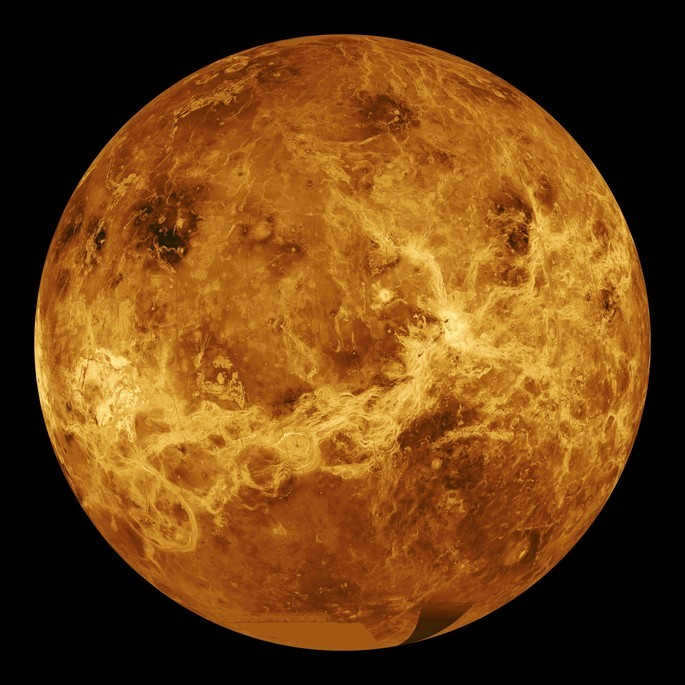
She is a member of the Earth group of planets (which consists of Mercury, Venus, Earth, Mars).
Features of Venus
| About 12,103.6 kilometers |
| About 6052 km |
| About 4.866E24 kg |
| +462°C |
| 5.204 g/cm³ |
| About 108 million km |
| Minimum – 38 million km, maximum – 261 million km |
| 0 |
| 243 days |
| 225 days |
Atmosphere
Venus possesses a dense and noxious atmosphere that is rich in carbon dioxide.
The atmospheric makeup is as follows:
- carbon dioxide: 96.5%
- nitrogen: 3.5%
- and various other elements in trace amounts.
This celestial body is frequently enshrouded in thick, yellowish clouds primarily composed of sulfuric acid, which creates a potent greenhouse effect by trapping heat.
Venus holds the distinction of being the hottest planet in our solar system, despite Mercury’s closer proximity to the Sun (i.e., the first planet in the lineup). The dense atmosphere of Venus generates a greenhouse effect that elevates its surface temperature to a scorching 471 °C.
The composition of Venus
Venus has a composition that closely resembles that of Earth, consisting of three main layers: the crust, mantle, and core.
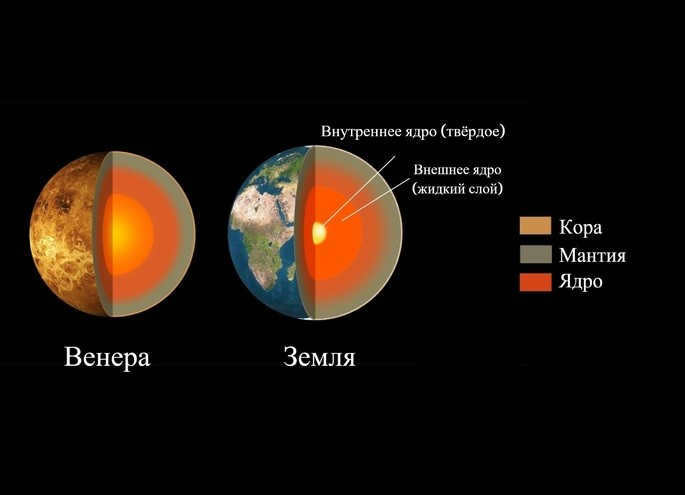
In theory, Venus is believed to have a core made up of metallic iron and nickel, with a radius ranging from 3200 to 6000 km. Surrounding the core is a mantle, whose composition is still unknown, with a thickness of approximately 2800-3000 km. Finally, there is a crust made up of basalt, a type of volcanic rock, which is estimated to be between 10-20 km thick, although some experts suggest it could be as thick as 50 km.
Venus has a magnetic field that is significantly less powerful than that of Earth. The cause of this disparity could be attributed to either the core of Venus or its rotational movement. Unlike Earth, Venus rotates at a much slower pace, completing one rotation every 243 Earth days. This sluggish rotation may result in a core that is not spinning quickly enough to generate a magnetic field, as seen in the cores of other celestial bodies.
Another potential explanation is that the core of Venus is entirely solid, or it might not even exist at all.
Venus, which is part of the Earth group, is positioned as the second planet from the Sun. Its relative proximity to Earth allows for convenient observation with a telescope, even during daylight hours. Since ancient times, humans have been captivated by the study of Venus, a pursuit that was finally concluded in 2015.
Venus
Venus, the goddess of love in ancient Rome, lends her name to the planet. Throughout history, Venus has captivated mankind as a unique celestial body. It shines brightly in the sky, resembling a star that never fades, even during the day when it can be seen with the naked eye.
As astronomy evolved into a scientific discipline, people’s fascination with Venus only grew. Ancient scientists were able to gather a relatively accurate description of the planet’s blue appearance long before the full understanding of the planetary system. Over the centuries, technological advancements have provided more specific data, but these findings have often been subject to change due to Venus’ peculiar nature within the solar system.
The Origin of Discovery
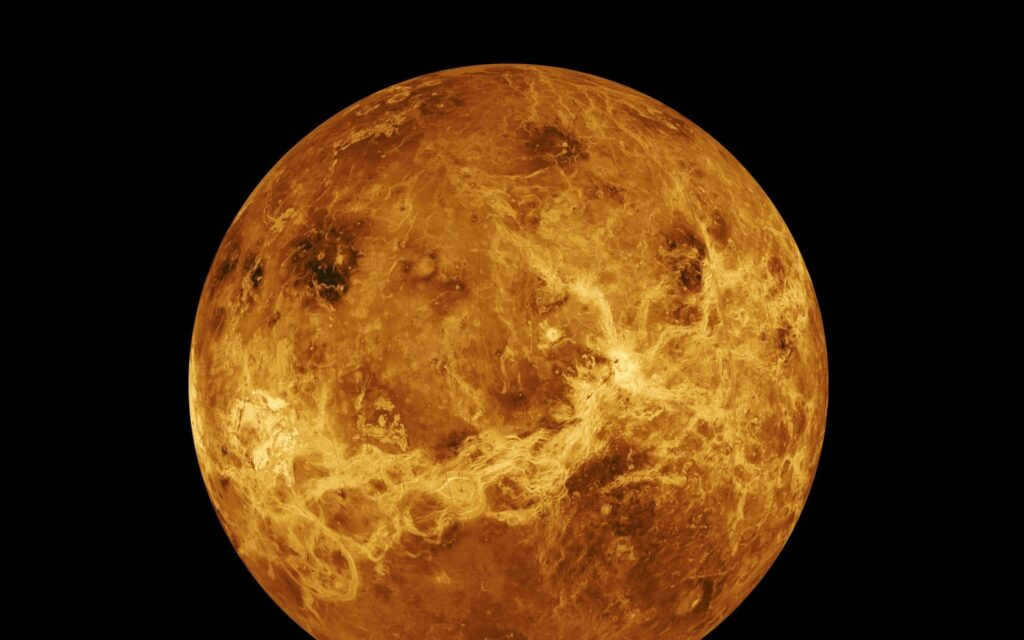
Venus, a celestial body shrouded in mystery, has been a subject of observation since ancient times. As early as the 6th century BC in ancient Babylon, a tablet was created documenting information about this enigmatic planet. The ancient Greeks bestowed upon it a name in honor of the Goddess of Love and Beauty, while the ancient Romans referred to its morning appearance as Lucifer, the God of Light.
- In the year 1032 A.D., Avicenus witnessed the rare occurrence of Venus passing in front of the sun, which led him to conclude that the planet is positioned closer to Earth than the Sun. In the 17th century, Galileo Galilei made a groundbreaking discovery with his instrument, observing the various phases of Venus. This pivotal finding provided further evidence for the theory that Venus completes a full orbit around the Sun.
- In 1761, M. V. Lomonosov made a significant finding when he observed the presence of an atmosphere on the planet. This observation was later verified by the German astronomer Johann Schroeter.
- In 1866, Chester Lyman observed a luminous ring on the dark side of the planet, indicating the presence of an atmosphere. In 1920, the initial ultraviolet survey provided further confirmation of this discovery.
- In 1950, scientists made the discovery of Venus’s retrograde rotation and its extremely slow rate of rotation.
- In 1960, radio waves were introduced as a tool for studying the planet.
Who was the person credited with the discovery of Venus?

One of the most well-known artworks featuring Nicolaus Copernicus was created by the Polish painter Jan Matejko between 1871 and 1873.
Awareness of the planet Venus dates back to ancient times. Copernicus’ model proposed that the planet orbits the Sun, a concept later confirmed by Galileo in 1610 when he observed its phases through a telescope. These theories eventually converged, providing scientific validation.
In the 1960s, the USSR initiated studies of Venus. Using radio waves, scientists were able to capture the first images of its surface. The first spacecraft to land on the planet was “Mariner-2,” which confirmed the planet’s high temperatures and disproved the possibility of life.
Venus has the densest atmosphere and the highest surface temperature among all the planets. The axis of rotation of Venus is tilted at an angle of 177.36 degrees relative to the plane of its orbit. From our perspective on Earth, this tilt causes Venus to appear to move in an east-west motion, starting from the north pole of the ecliptic. This is opposite to the rotation direction of the other six objects in our solar system.
A day on Venus lasts for 243 Earth days, while a solar day on Venus is equivalent to 116.8 Earth days. It takes Venus 146 Earth days to complete one revolution around the Sun. The synodic period of Venus, which is the time it takes for Venus to return to the same position relative to Earth, lasts for 584 days.
During each approach to Earth, Venus always presents the same side towards us. The reason for this phenomenon is still unknown to scientists.
Orbit and radius
This celestial body is relatively small. Venus has a radius of around 6,052 kilometers. Its orbit is nearly a flawless circle.
The distance between Venus and the Sun fluctuates between 107.5 and 108.9 million kilometers. One Venusian year lasts for 224.45 days, which is the duration of a full orbital revolution.
Rotation around its own axis
Venus takes longer than a year – 247 Earth days – to complete a full rotation around its own axis. Interestingly, Venus returns to the same point relative to the Sun much quicker than it completes one revolution around itself.
Causes of the backward motion of Venus
The phenomenon of reverse rotation is not exclusive to Venus alone; Uranus also exhibits this peculiar behavior. Conversely, the other six planets rotate in a counterclockwise direction.
One possible explanation for this reverse rotation could be the influence of the planet’s dense atmosphere on tidal forces. The motion of the planet is initially slowed down and eventually reversed due to this effect.
Planet’s Physical Attributes: Size, Mass, and More
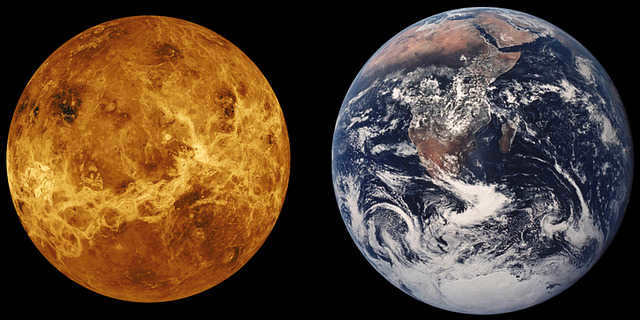
Venus is a planet that has a similar size to Earth, although it is slightly smaller. Its surface area measures 460 million km2, while its volume is 928 billion km2. The acceleration of free fall on Venus is 8.88 m/s2.
With a mass of 4.866 x 1024 kilograms, Venus is about 84% the mass of Earth.
Venus has a high density due to its abundance of metals and other hard rocks. There are three theories regarding the composition of the planet’s core. According to two theories, which classify Venus as a member of the Earth group, it has an iron core surrounded by a molten mantle. However, one theory suggests that the core is solid, while another proposes that it is in a liquid state.
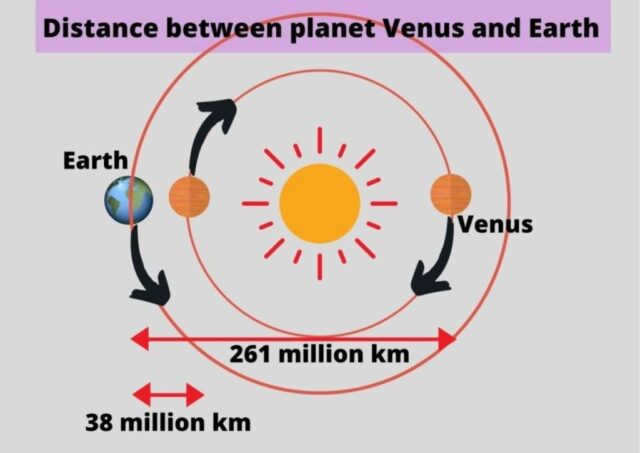
This celestial body within our solar system will be classified in the same terrestrial group as the other three neighboring planets, namely Mercury, Earth, and Mars.
When considering its proximity to the Sun, it is the second planet. In terms of size, it falls sixth on the spectrum. Venus has the distinction of being the third brightest entity in the sky, following the Sun and the Moon. This luminous planet shines with equal intensity during both the day and the night.
Venus bears a resemblance in its external attributes to Earth.
Theoretically speaking, several billion years in the past, Venus may have supported the presence of water, and its surface temperature oscillated around 80 degrees.
In contrast to Earth, Venus does not possess any natural satellites; scientific speculation suggests that any satellites Venus might have had were possibly engulfed by the Sun.
Similar to Mercury, this planet also maintains a relatively close proximity to the star, reaching a maximum of 47 degrees. The orbit of Venus boasts an eccentricity of 0.0067, rendering it nearly perfectly circular.
The velocity of celestial bodies
Venus takes 116.75 Earth days to complete a solar day, during which it traverses its entire path across the sky.
The sidereal day on Venus has a duration of 243.025 days, and it is directly influenced by the planet’s rotation.
A year on Venus is 61.5% of Earth’s year, and every 584 days, Venus aligns with the Sun and Earth, coming within a distance of less than 41 million kilometers from our planet.
Astronomical features
Venus, known as the “Morning Star” or the “Evening Star,” stands out as the most luminous object in the sky, easily visible from Earth before dawn and after dusk.
With its unique white hue and significantly brighter radiance, it is unmistakable and cannot be mistaken for any other star.
As it crosses the Sun’s disk
Approximately every 250 years, the planet’s trajectory intersects the star’s disk on about four occasions. The planet completes two crossings in December and two more in June. The most recent crossing occurred on June 6, 2012, and the next one is expected around December 11, 2117.
This occurrence was initially observed by an English scientist named Jeremiah Horrocks on December 4, 1639. M. V. Lomonosov also documented the same phenomenon on June 6, 1761. Lomonosov’s account provided the most comprehensive description and enabled the calculation of the distance between Venus and the Sun.
This event was eagerly anticipated by scientists from various countries and the global community of astronomers. In order to calculate the phenomenon of parallax, it was necessary to record the movement of Venus during a specific time interval from different locations on Earth.
Recognizing the importance of this event, M. V. Lomonosov arranges an expedition to Siberia. In his scientific writings, the Russian scientist became the first in the world to document a more detailed observation of the planetary and stellar discs when their edges overlap. The astronomer was able to detect the faint glow emitted by Venus when it makes contact with the Sun.
This phenomenon was observed by several astronomers, but only M. V. Lomonosov was able to witness it. V. Lomonosov was able to give a written account of this phenomenon, which later became known as the “Lomonosov phenomenon”. Devoting considerable time to the physical study of Venus, M. V. Lomonosov explains the halo as a phenomenon in which light rays are refracted – refraction.
At the same time, Mikhail Vasilyevich proposes that the existence of an atmosphere creates a certain similarity to Earth.
Video: Venus passing across the face of the Sun
Satellites
Venus does not have any natural satellites. One version suggests that in the past, the planet may have had a satellite in the form of Mercury.
Through numerical modeling, scientists Tom Van Flandern and R. S. Harrington have provided justification for the “lost satellite” theory. This theory explains the significant eccentricity of Mercury’s orbit and its unusual circulation around the Sun. Furthermore, it also explains the retrograde rotation of Venus and its abnormally high temperature throughout its surface, which affects the density of its atmosphere.
Asteroid 2002 VE68 orbits in close proximity to Venus. For a considerable period of time, this quasi-satellite has been positioned in a way that forms a resonance, keeping it close to its orbit.
All of the assertions regarding Venus satellites were made three centuries earlier. The astronomical community made over twenty assertions, but they were all incorrect. In the final years of 1770, all efforts to uncover the existence of a Venus satellite were abandoned.
Venus’s Age
Venus is approximately 4.5 billion years old. The planet began forming around the same time as the other planets in the solar system. The age of Venus, as well as other planets, has been calculated using radiocarbon dating. The findings from this research were consistent.
Exploring Venus
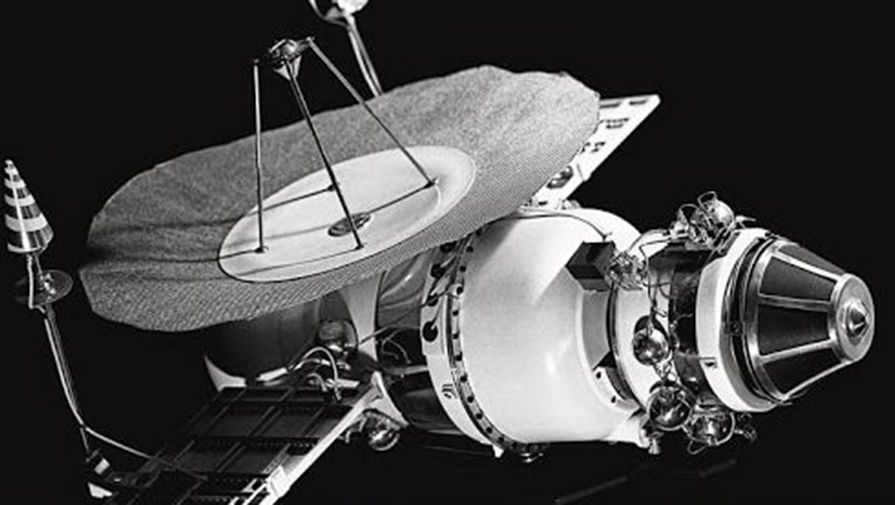
In 1966, the Soviet Venera-3 became the first spacecraft to successfully touch down on the surface of Venus. Unfortunately, communication was lost immediately after landing. The following year, the Soviet Venera-4 attempted a similar mission, gathering data on the planet’s pressure and temperature before attempting a landing. However, due to a discharged battery, the spacecraft was unable to make a successful landing and communication was once again lost.
The exploration of the universe using optical telescopes commenced during the 17th century. Galileo Galilei was the first to utilize a telescope to observe a planet, specifically Venus, in 1610. This groundbreaking study led Galileo to discover that Venus exhibits phases and that its light is actually reflected sunlight.
In 1639, J. Horrex, an English astronomer, observed the transit of Venus across the Sun’s disk through the aid of a telescope.
In 1710, M. Lomonosov made an intriguing observation of a glow on Venus while examining it with a telescope, suggesting the presence of an atmosphere. As each century passed, telescopes continued to advance, enabling astronomers to gain further insights into the planet and conduct more comprehensive studies of Venus’ structure.
Spacecraft Exploration of Venus
Active investigation of Venus commenced in the 1960s with simultaneous efforts from two nations: the USSR and the United States. The initial spacecraft launched towards Venus was the Soviet Venera-1. Unfortunately, the mission came to an abrupt end when the spacecraft crashed while entering the planet’s upper atmosphere. A year later, additional missions including Venera, Vega, Pioneer-Venera-1,2, and Mariner were launched by both the Soviet and American teams.
In 1975, the “Venera-9” and “Venera-10” missions successfully captured the first images of the planet.
In recent decades, only three spacecraft have been involved in exploration missions. The comprehensive study of Venus was officially concluded in 2015.
Reasons Behind the Naming of Venus
In the solar system, various celestial bodies are named after Roman gods, and the planet Venus is no exception. What sets it apart is that it is the sole planet named after a female character from ancient Roman mythology – the goddess of beauty and love.
Throughout history, different civilizations have had their own names for this planet. The ancient Babylonians referred to it as Ishtar, while the Egyptians called it the Morning Star and Evening Star. However, the Romans chose to name it Venus. This goddess is featured in numerous myths and is revered in various ancient cultures. She holds a sacred significance and is seen as a protective amulet – a star that will only fade away at the end of the world, during humanity’s twilight.
Planetology
The study of the surface of Venus became possible in the 1960s, thanks to the development of radar technology. The most detailed map of the landscape was created by the American spacecraft Magellan, which successfully captured 98% of the planet’s surface. During this study, large-scale elevations on Venus were discovered and named the Land of Ishtar and the Land of Aphrodite.
The surface of Venus is composed of frozen basaltic lava, which formed approximately 500 million years ago.
In 2009, the Venus Express spacecraft provided a map of the planet’s southern hemisphere for further study. This data gave rise to hypotheses about the existence of a vast ocean in the distant past and the occurrence of powerful tectonic plate movements.
Venus’s composition and surface characteristics
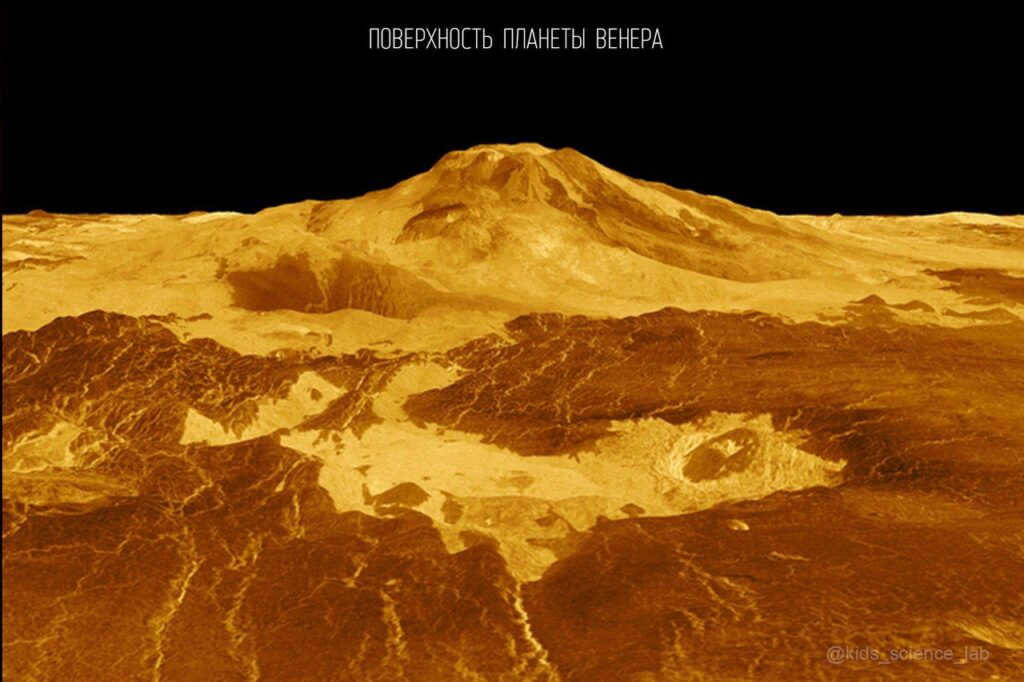
The density of the surface of Venus is significantly higher compared to that of Earth. Unlike Earth, Venus does not possess a magnetic field. Volcanoes make up a substantial portion of its composition, with approximately 170 of them potentially active at present.
Currently, Venus does not experience plate tectonic movement. The upper layer of its surface consists of solidified lava, which originated from the planet’s interior and solidified millions of years ago.
The composition of Venus
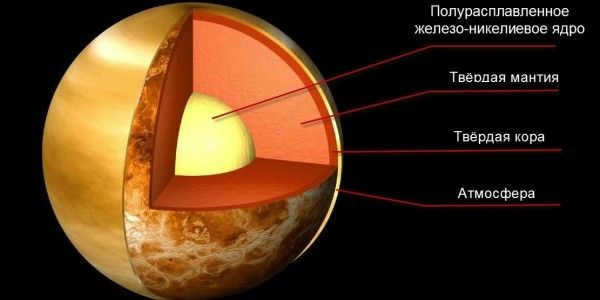
There is an ongoing scientific debate regarding the composition of the planet. Currently, there are three models that illustrate its internal structure. The most commonly accepted model, favored by scientists, is comprised of three layers.
The initial layer is known as the crust, measuring 16 kilometers in thickness.
The second layer, referred to as the silicate mantle, extends approximately 3,300 kilometers deep. It accounts for a quarter of the planet’s overall mass.
The third layer is the solid iron core, with a density of 14 g/cm3.
Venus’s solid core
The core of Venus, both inner and outer, is composed of solid material. This conclusion is supported by the fact that the planet does not have a magnetic field. As a result, there is no flow of electric current within the core, and its particles remain stationary.
Determining the exact structure of Venus’s core is challenging due to the extreme conditions on the planet. On Earth, scientists rely on seismometers to study the core, but these instruments are not suitable for use on Venus.
Seismic waves take a significant amount of time to travel through the depths of a planet, and no device has yet been developed that can withstand the immense pressures found within Venus’s core.
Atmosphere
The atmosphere is the layer of gases that surrounds a planet or other celestial body. It is held in place by gravity and is composed of various gases such as nitrogen, oxygen, carbon dioxide, and trace amounts of other gases. The atmosphere plays a crucial role in supporting life on Earth by providing oxygen for respiration, regulating temperature, protecting against harmful radiation, and facilitating the water cycle. Understanding the composition and dynamics of the atmosphere is essential for predicting weather patterns, studying climate change, and exploring other planets.
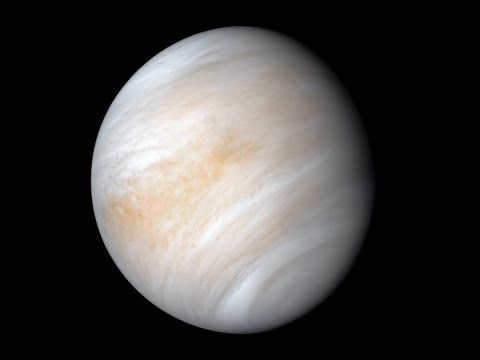
Venus possesses the highest density of atmosphere among the eight celestial bodies. The lower layers are enveloped in dense, opaque white clouds, obstructing any view of its surface. The atmospheric composition consists of various noxious gases: 96% carbon dioxide, 3% nitrogen, and 1% sulfur.
The greenhouse effect, caused by carbon dioxide, is responsible for the extreme heat on the planet.
The temperature decreases as one moves further away from the surface. At an altitude of 200 km, the temperature abruptly drops to 46 ° C.
Weather and climate of Venus
Venus experiences high temperatures not only on its surface due to its thick sulfur clouds, but also in its depths. This is a result of the cessation of tectonic plate movement. The temperature remains at a constant 477 degrees Celsius, with little variation even in shaded areas.
The main cause of Venus’ anomalously high temperature is the greenhouse effect. Without it, the planet’s highest temperature would not exceed 80 degrees Celsius.
The planet is also known for its strong hurricanes, with average wind speeds reaching 300 m/s and an atmospheric pressure of 92 atmospheres.
In the upper layers of the troposphere, there are periodic occurrences of acid rain. However, these rains do not reach the planet’s surface as they rapidly evaporate, creating a phenomenon known as virga in the atmosphere.
Video: transforming a scorching planet
Venus’s Temperature
With surface temperatures reaching extreme highs, Venus holds the title for being the hottest planet among the eight in our solar system. These scorching temperatures can be attributed to the greenhouse effect, which is caused by the presence of an extensive layer of sulfuric acid clouds.
The average temperature on Venus hovers around 460 °C, maintaining this intensity across the entire planet. Additionally, the planet’s low axial tilt contributes to the absence of significant seasonal variations in temperature.
Winds on Venus
Venus experiences powerful winds that transform into storms. On average, these winds reach speeds of up to 85 km/s, making it possible to circumnavigate the entire planet in just 5 days.
At its most extreme, the wind on Venus can reach speeds of 355 – 700 km/h. However, closer to the planet’s surface, the wind weakens significantly, with movement above the surface not exceeding 1 – 2 m/s.
Clouds and the impact of the greenhouse effect on Venus
Clouds on Venus are present at a distance of 48 to 65 km from the surface all year round. These clouds are composed of hydrogen sulfide and carbon dioxide, giving them a high density that hinders the transmission of sunlight. This density plays a crucial role in preventing the escape of heat into outer space, thereby preventing the planet from cooling down. As one descends closer to the surface of Venus, the temperature increases significantly.
Based on a certain hypothesis, it is believed that Venus and Earth were once identical. Recent research on the atmosphere has revealed a trace amount of phosphine, a gas that suggests the potential existence of past life on Venus. Additionally, there is a small concentration of water vapor (0.002%) in the planet’s atmosphere, indicating the possibility of once having seas and oceans. This is further supported by the presence of ravines across the planet.
However, due to extremely high temperatures, the presence of water on Venus is currently impossible.
Planetary Seasons
Venus lacks distinct seasons due to its small axis tilt of only 3 degrees. The temperature remains relatively constant across the planet’s surface, averaging around 455 °C.
Earth versus Venus
Venus and Earth share some similarities in their internal structures, as mentioned earlier in this article, earning them the nickname “sisters.” However, these planets also have notable differences.
While Earth is situated approximately 149,598,022 km from the Sun, Venus is positioned at an average distance of 108,208,000 km. Additionally, Earth has a tilt of 23.5 degrees on its axis, while Venus has a tilt of 2.64 degrees.
There is no core convection or magnetic field on Venus. The atmospheric pressure on Venus is the highest among all the planets in the Solar System. The main distinction is the absence of water. The climate on Venus is inhospitable for supporting life.
Venus’s rotation period
The rotation period of Venus, which is the time it takes for the planet to complete one revolution around its axis, is longer than its revolution around the Sun.
Opposition of Planets
The planet’s density is only 0.3 g/m3 lower than that of Earth, which is significant. Based on extensive research conducted until 2015, Venus shares many similarities with Earth in terms of its structure.
Despite having a higher temperature in its upper atmosphere, Venus is much closer to Earth in this aspect. However, the planet still presents inhospitable conditions for sustaining life.
- In 1962, the American Mariner 2 spacecraft successfully explored Venus by passing within 34,833 kilometers of its surface and conducting precise measurements.
- Venus has been at the forefront of space exploration, being the first planet to have its surface reached by an artificial object. In 1966, “Venus 3” became the first vehicle to successfully land on its surface.
- Venus is nearly the same size as Earth, with its surface being only 638 kilometers smaller. Additionally, its mass is 81.5 percent similar to that of Earth.
- Venus experiences extremely high temperatures, with temperatures in the shade reaching around 400°C and the planet’s normal temperature being in the range of 462°C.
- Venus has an immense pressure: The planet’s pressure is 92 times that of Earth. In the depths of a volcanic canyon, the pressure can reach up to 117 bar.
- Venus has a clockwise rotation: Unlike the three other terrestrial planets, Venus rotates in the opposite direction, similar to Uranus.
- Surviving on Venus is impossible for humans: The current conditions on Venus make it unsuitable for sustaining human life, with less than 1 second being survivable.
- Venus is one of two planets that can be observed transiting the Sun’s disk: Mercury and Venus are the two planets that can be observed passing in front of the Sun’s disk.
- Possible existence of life on Venus: The presence of phosphine gas in a small percentage of Venus’s atmosphere has raised the possibility of some form of life existing on the planet.
- Venus has an unpleasant smell: The atmosphere contains high concentrations of sulfur dioxide and hydrogen sulfide, creating an odor similar to rotten eggs.
- On Venus, a day is longer than a year: A year on Venus is equivalent to 225 Earth days, while a sideric day lasts 243 days.
Recent updates on Venus
On May 17, 2021, Roscosmos announced plans to allocate 318 million rubles from the budget to support the Venera-D project. This project aims to be the first Russian automatic station dedicated to studying the structure of Venus.
On June 5, 2021, NASA expressed interest in discussing collaborative plans with Russia for exploring Venus.
November 21, 2021, has been set as the deadline for Russia to implement the Venera-D project.
On August 13, 2022, France decided to withdraw from its partnership with Russia in creating instruments for studying Venus.
On 02.02.2023, a team of Russian engineers and scientists have successfully developed a groundbreaking vehicle specifically designed to explore the enigmatic surface of Venus.
Just recently, on April 10, 2023, the Russian Academy of Sciences proudly declared the accomplishment of a major milestone in the ambitious Venera-D project. Additionally, an official launch date has been officially scheduled for the preliminary phase of the mission.
With great anticipation, the Venera-D spacecraft is planned to be launched after 2030, precisely on April 12, 2023. This highly advanced apparatus holds the promise of unlocking unprecedented knowledge about the mysteries surrounding Venus.
A captivating video
Venus, named after the ancient Roman goddess of love, is a planet in our solar system. It holds the distinction of being the second most distant planet from the Sun and is known for its completely uninhabitable conditions, largely due to the presence of a strong greenhouse effect. Let’s delve into the unique characteristics and intriguing facts about this fascinating planet.
General information
Venus, the second planet from the Sun, is classified as one of the terrestrial planets, alongside Mercury, Earth, and Mars. Its close proximity to the Sun makes it one of the hottest planets in our solar system.
In terms of size, Venus is relatively modest. With a radius of approximately 6052 kilometers, it ranks as the sixth largest planet in our solar system. By comparison, the gas giant Neptune boasts a radius of 24622 km.
Venus orbits the Sun in an almost perfect circular path. Its journey around the Sun takes approximately 224.65 days. The rotation of Venus on its axis is extremely slow, with one day on the planet lasting 247 Earth days. This means that Venus completes its orbit around the Sun at a faster pace than it rotates on its own axis.
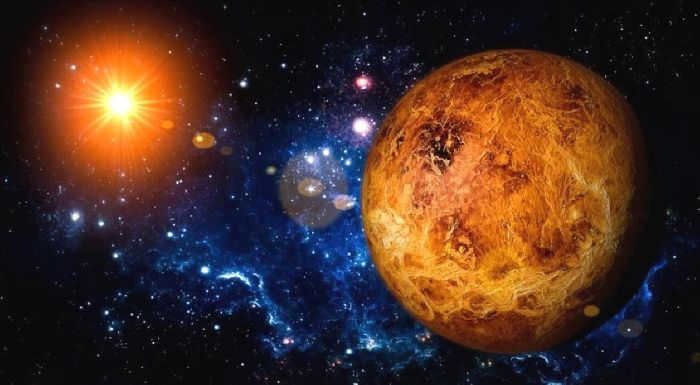
Important physical characteristics of the planet include:
- an equatorial radius of 6,052 kilometers;
- a surface area of 4.60-108 square kilometers;
- volume – 9.Z8-1011 cubic kilometers;
- mass – 4.86-1024 kg;
- average density – 5.24 g/cubic centimeter;
- and an axis tilt of 177.6°.
What sets Venus apart from the other planets in the Earth group is its unique direction of rotation. Unlike the other planets that rotate counterclockwise, Venus rotates in the opposite direction. This is an important detail to mention in a geography lesson when discussing the characteristics of the planets.
Characteristics of the Venusian Atmosphere
Venus, often referred to as Earth’s sister, shares similarities in mass, size, and composition with our planet. However, the conditions on Venus are drastically different and unsuitable for supporting life. The primary reason for this is its atmosphere, which is the densest among all the planets in the solar system.
The Venusian atmosphere is composed mainly of carbon, accounting for 96% of its volume. The remaining volume is made up of nitrogen (3%) and sulfur (1%). The abundance of carbon dioxide in the atmosphere leads to a powerful greenhouse effect, resulting in surface temperatures exceeding 460°C at altitudes up to 3 km. Only at a height of 200 km does the temperature in the Venusian atmosphere become comparable to that of Earth, reaching around 46°C.
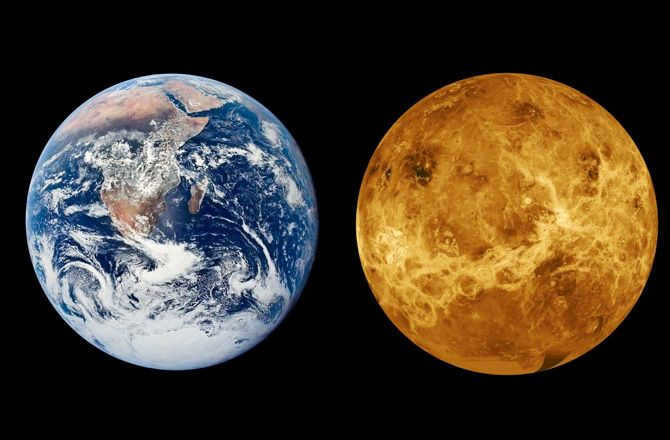
Venus has an atmospheric pressure that is 92 times greater than Earth’s pressure. The planet is enveloped by a dense layer of sulfuric acid clouds, which made it difficult for scientists to determine the appearance of Venus’ surface. It was only through the use of radar methods that they discovered numerous signs of volcanic activity on the planet. Despite the absence of active volcanoes and a scarcity of craters, Venus’ surface is believed to be relatively young, estimated to be around 500 million years old.
Powerful winds are a common occurrence on Venus, reaching speeds of up to 85 km/s. These winds can encircle the entire planet in just 5 days and are sometimes accompanied by lightning.
Characteristics of the arrangement
Based on the most likely hypothesis, the composition of Venus is comprised of a relatively thin outer layer measuring approximately 15 km in thickness, followed by a much thicker mantle spanning about 3000 km, and finally a substantial iron-nickel core.
Unlike Earth, Venus does not possess a magnetic field, which can be attributed to the absence of charged particles in its core that are capable of movement. Consequently, the core of the planet is extremely solid due to the lack of any internal motion.
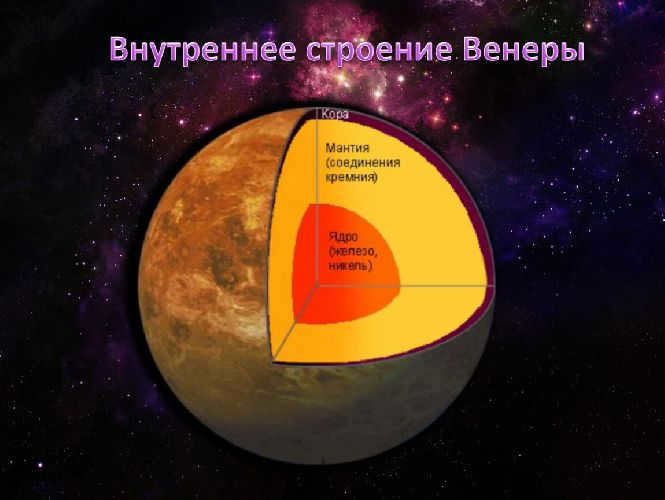
Due to its positioning, Venus is observable from the Earth without the aid of telescopes. It is visible even during daylight and presents itself as a luminous celestial body during the night. It stands out as one of the most radiant entities in the celestial realm, known as the “morning star,” showcasing its brilliance during both sunrise and sunset.

